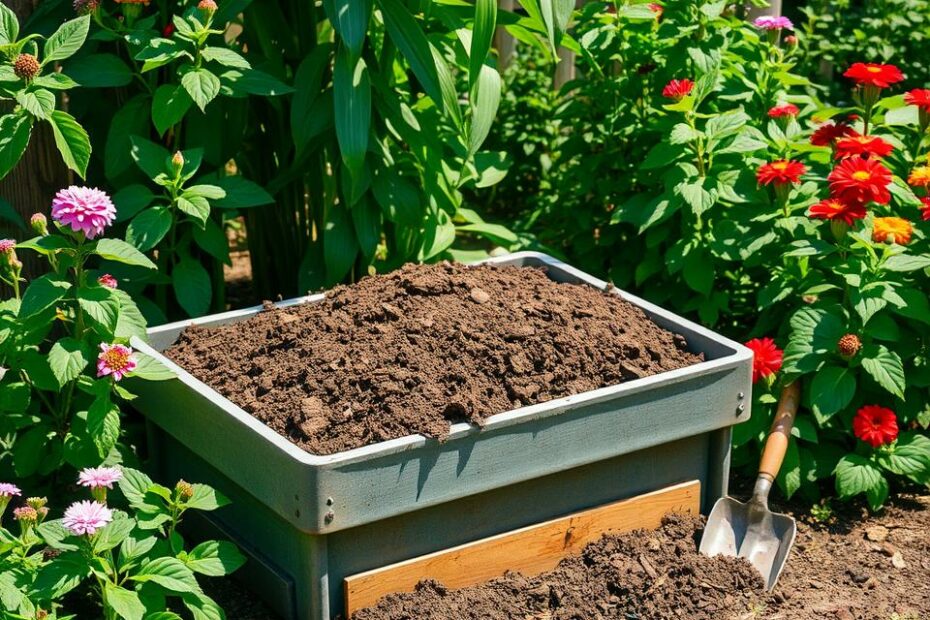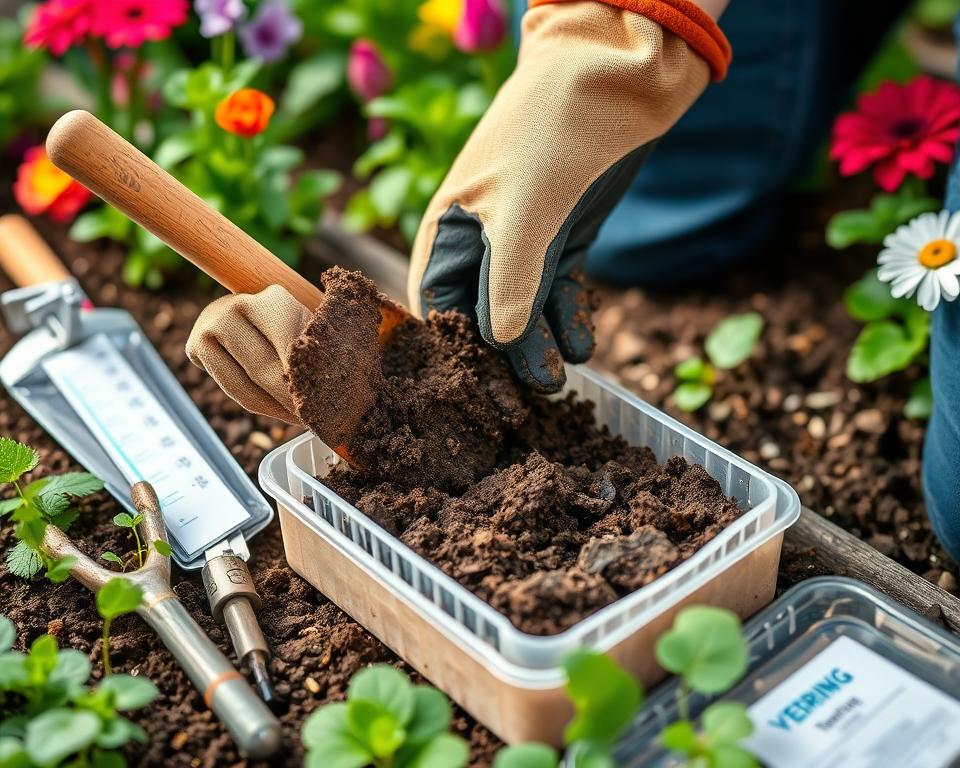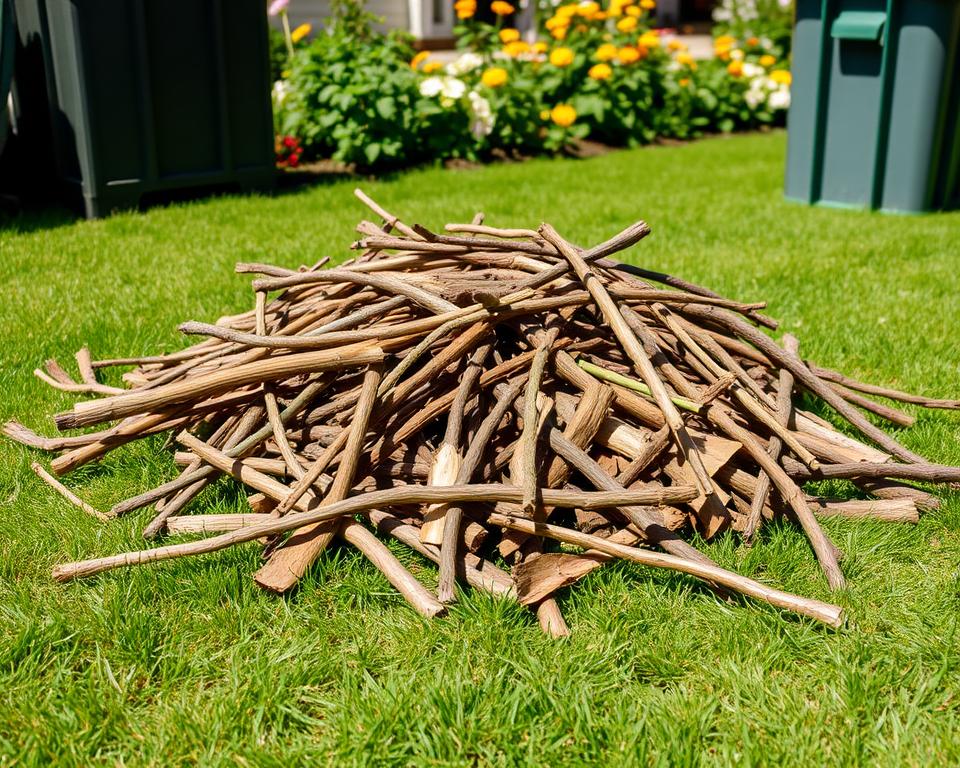As a passionate gardener, I’ve always been acutely aware of the importance of properly disposing of used potting soil. It’s not just about keeping our gardens healthy, but also about protecting the environment and ensuring sustainable waste management practices. In this comprehensive guide, I’ll share practical tips and eco-friendly solutions for disposing of your old potting soil, so you can feel good about your gardening habits and contribute to a greener future.
Key Takeaways
- Proper disposal of potting soil is crucial for environmental conservation and responsible waste management.
- Explore various eco-friendly methods to dispose of used potting soil, including composting, recycling, reusing, and working with local waste facilities.
- Understand the importance of soil disposal, the risks of improper handling, and practical solutions for gardeners and homeowners.
- Learn about the composition of potting soil and the methods for environmentally friendly disposal.
- Discover the benefits of soil recycling and composting, as well as creative ways to repurpose old potting soil.
The Importance of Proper Potting Soil Disposal
Responsible soil management is crucial for maintaining a healthy environment. Improper disposal of potting soil can lead to serious environmental consequences, such as soil contamination, landfill impact, and damage to local ecosystems. Understanding the environmental impact of soil disposal is the first step in adopting sustainable practices that minimize waste and promote soil health.
Environmental Impact of Improper Disposal
When potting soil is carelessly discarded, it can release harmful chemicals and pollutants into the soil and waterways. This can lead to the contamination of groundwater, surface water, and even the air through the release of greenhouse gases. Additionally, the presence of hazardous soil disposal in landfills can have long-term negative effects on the surrounding environment.
Soil is a finite and invaluable resource that is essential for growing food, building, and storing carbon. By adopting sustainable soil practices, we can protect this vital resource and reduce our environmental footprint.
Responsible Soil Management
Responsible soil management involves understanding the impact of disposal methods and implementing practices that minimize waste and promote soil health. This can include recycling or composting potting soil, reusing it in your garden, or properly disposing of it at local waste facilities. By taking an active role in the management of our soil resources, we can contribute to a more sustainable future.
Recycling and Composting Potting Soil
As gardeners, we have a responsibility to dispose of used potting soil in an eco-friendly manner. Fortunately, recycling and composting offer sustainable solutions that can benefit both our gardens and the environment. By embracing these practices, we can reduce waste, conserve resources, and create nutrient-rich soil amendments to nourish our plants.
Benefits of Soil Recycling
Recycling used potting soil offers numerous advantages. It helps reduce energy consumption and greenhouse gas emissions associated with the production and transportation of new potting soil. Additionally, it decreases the amount of waste sent to landfills, contributing to a more sustainable waste management system.
Composting Process for Potting Soil
- The composting process breaks down the organic matter in used potting soil, transforming it into a nutrient-rich compost.
- This compost can then be incorporated back into garden beds, providing valuable organic matter and nutrients to improve soil structure and fertility.
- Composting potting soil also helps reduce waste and supports sustainable gardening practices.
| Statistic | Value |
|---|---|
| Percentage of Unused Potting Soil | A significant portion of potting soil is left unused at the end of the gardening season, leading to a need for proper disposal methods. |
| Percentage Increase in Recycling Awareness | The text highlights a shift in societal consciousness towards waste management, evidenced by the elimination of disposable items like straws and bags, indicating a growing concern for sustainable practices. |
| Prevalence of Recycling Practices in Gardening | The text suggests that disposing of old potting soil is no longer acceptable, implying a trend towards reusing and recycling gardening materials. |
By embracing potting soil recycling and composting, gardeners can contribute to a more sustainable future. These practices not only reduce waste but also provide valuable organic matter and nutrients to nourish our gardens, creating a harmonious cycle of organic matter recycling.
Reusing Potting Soil in Your Garden
As a sustainable gardening practice, reusing potting soil can be an excellent way to amend your garden beds and rejuvenate the soil. Potting soil is specifically designed to stay fluffy, well-draining, and nutrient-rich, making it a valuable resource for improving the texture and fertility of your garden soil.
Many potting soil mixes contain ingredients like perlite, rice hulls, and peat moss that enhance the soil’s structure without providing significant nutrients. These components often don’t decompose over time, helping to maintain the soil’s desirable texture. However, the organic matter in potting soil, such as compost or manure, can deplete nutrients as it breaks down.
To reuse your old potting soil effectively, consider mixing it with fresh compost or other organic amendments. A ratio of approximately 1 part compost to 3 parts potting soil is recommended for amending garden beds. This combination will not only improve the soil’s texture but also replenish the essential nutrients plants need to thrive.
Alternatively, you can add targeted organic fertilizers or nutrient-rich worm castings to the reused potting soil to ensure your plants receive the necessary nourishment. This approach can save you money and resources while promoting sustainable gardening practices.
Remember, before reintroducing potting soil into your garden, it’s important to thoroughly clean and sterilize the soil to eliminate any potential pathogens. This can be achieved through solarization, baking in the oven, or microwaving the soil. Once sterilized, the soil can be replenished with the appropriate amendments to create a thriving, nutrient-rich growing medium for your plants.
Dispose potting soil at Local Waste Facilities
When it comes to disposing of used potting soil, many local governments offer dedicated recycling facilities or waste management programs designed to handle these materials responsibly. These facilities often provide clear guidelines on how to properly prepare and transport the soil for disposal or recycling, ensuring it is handled in an environmentally-responsible manner.
Guidelines for Disposal at Recycling Centers
Exploring local soil disposal options can be a smart way to keep used potting soil out of landfills and waterways. Some key guidelines to follow when disposing of potting soil at recycling centers include:
- Separate the soil from any containers or debris before transport.
- Use brown compost bags or other designated containers provided by the recycling program.
- Follow any specific instructions provided by the local recycling center, such as drop-off procedures or contamination guidelines.
- Avoid mixing potting soil with other yard waste or household trash to ensure proper processing.
Many cities offer “leaf and yard waste drop-off” programs in the fall that accept used potting soil, flowerpots, and dead plants. These materials are then processed into nutrient-rich compost. Commercial composting companies also have specialized equipment to safely heat and treat soil and organic matter for reuse.
| Benefit | Description |
|---|---|
| Reduced Waste | Soil recycling reduces the amount of potting soil sent to landfills, decreasing waste and environmental impact. |
| Sustainability | Recycled soil can be used to enrich garden beds and improve soil structure, promoting more sustainable gardening practices. |
| Cost Savings | Disposing of soil through municipal programs is often more cost-effective than hiring a private hazardous waste removal service. |
Creative Ways to Repurpose Potting Soil
Potting soil is a valuable resource that can be creatively repurposed for various landscaping and gardening projects. Instead of simply discarding used potting soil, consider these innovative ways to give it a new life and reduce waste.
Using Soil for Landscaping Projects
Potting soil can be an excellent filler material for landscaping features such as berms, raised planters, and other garden structures. Incorporating used potting soil into the construction of these elements can help improve soil structure, drainage, and nutrient content, providing a healthy growing environment for plants.
Creating Raised Garden Beds
Repurposing potting soil is an ideal way to build sustainable raised garden beds. By mixing used potting soil with new soil or compost, you can create a nutrient-rich growing medium that supports the healthy growth of your favorite vegetables, herbs, and flowers. This approach not only reduces waste but also promotes sustainable soil management.
Regardless of how you choose to repurpose your potting soil, it’s important to ensure that the soil is not contaminated or harboring any pests or diseases. Proper handling and treatment, such as heat-treating or mixing with new materials, can help maintain the soil’s health and suitability for reuse.
Handling Contaminated or Diseased Soil
When it comes to potting soil, proper disposal is crucial, especially if the soil is contaminated or contains diseased plant material. Identifying the type and level of contamination is the first step in determining the appropriate disposal method. Factors such as the presence of heavy metals, pesticides, or other hazardous materials can indicate the level of soil contamination.
Identifying Contaminated Soil
Soil contamination can occur due to a variety of reasons, including the use of persistent herbicides like picloram, clopyralid, aminopyralid, and aminocyclopyrachlor. These chemicals can persist in the environment for months, posing a threat to sensitive plants and the overall ecosystem. Herbicide-contaminated compost is an ongoing issue, with even tiny amounts (as low as 3 parts per billion) capable of impacting some garden plants.
Disposal Methods for Hazardous Soil
Proper disposal of contaminated or diseased soil is essential to protect the environment and human health. Specialized facilities or landfills are often the safest options for disposing of hazardous soil. Home composting bins may not reach the necessary temperatures to kill pathogens, so it’s important to avoid composting diseased plant material. Instead, bury diseased material at least 30 cm deep to prevent future contamination. For woody material or rootballs, disposal at a council refuse site or recycling center may be the best solution.
Maintaining soil health and preventing the spread of hazardous substances or pathogens is a critical aspect of responsible gardening and land management. By following proper soil testing and disposal procedures, gardeners and homeowners can ensure the safety of their local environment and protect the plants and wildlife that depend on it.
Professional Soil Removal Services
When it comes to disposing of heavily contaminated or hazardous potting soil, hiring a professional soil removal service may be the best course of action. These specialized companies possess the expertise and equipment necessary to safely handle, test, and dispose of problematic soil materials in compliance with local regulations.
When to Hire a Professional
There are several scenarios where seeking the assistance of a professional soil removal service is recommended:
- The potting soil is suspected of being contaminated with hazardous substances, such as heavy metals, pesticides, or other pollutants.
- The soil has been exposed to or is suspected of being infected with harmful pathogens or diseases that could pose a risk to the environment or human health.
- The volume of soil to be disposed of is too large for the homeowner to handle safely or responsibly through alternative means.
- The homeowner lacks the necessary equipment, expertise, or resources to properly test, transport, and dispose of the contaminated soil.
Professional soil remediation services can ensure the proper contaminated soil disposal and hazardous waste management protocols are followed, minimizing the environmental impact and protecting public safety. These companies typically provide comprehensive soil testing and analysis to identify the nature and extent of any contamination before developing a tailored professional soil removal plan.
| Service | Average Cost Range |
|---|---|
| Renting a Dumpster for Dirt Removal | $220 to $580 per week |
| Hiring a Junk Removal Company for Soil Disposal | $200 to $600 per load |
| Dumping Unused Dirt Yourself | Around $40 per ton |
By utilizing the expertise of a professional soil removal service, homeowners can ensure the safe and responsible disposal of contaminated or hazardous potting soil, protecting the environment and their own health and safety.
Costs and Regulations for Soil Disposal
When it comes to disposing of potting soil, understanding the associated costs and regulatory guidelines is crucial. The soil disposal costs can vary significantly depending on factors such as the level of contamination, the disposal method, and the location.
According to industry statistics, the average cost for dirt removal ranges from $140 to $180 per ton. For fill dirt, the cost to remove and haul off can be $140 to $230 per cubic yard, with an approximate $1,400 to $2,300 per truckload, plus labor fees. For contaminated soil, the removal and remediation costs can be even higher, ranging from $140 to $450 per ton on average.
In addition to the disposal costs, soil testing requirements can also contribute to the overall expenses. Soil test costs typically range from $25 to $200, depending on the specific tests required. Proper soil testing is essential to identify any potential contaminants and ensure compliance with environmental regulations.
| Cost Factor | Average Range |
|---|---|
| Dirt Removal | $140 to $180 per ton |
| Fill Dirt Removal and Hauling | $140 to $230 per cubic yard, $1,400 to $2,300 per truckload |
| Contaminated Soil Removal and Remediation | $140 to $450 per ton |
| Soil Testing | $25 to $200 |
Understanding the local disposal guidelines is also essential. Regulations may vary by region, and improper soil disposal can result in hefty fines and environmental damage. Consulting with local authorities or seeking professional guidance can help ensure compliance and responsible soil management.
By being aware of the potential costs and regulations associated with soil disposal, gardeners and homeowners can make informed decisions about the best way to handle their potting soil. Responsible soil management not only protects the environment but can also help minimize the financial burden of improper disposal.
Conclusion
Proper disposal of potting soil is essential for environmental conservation and responsible waste management. By exploring eco-friendly methods such as composting, recycling, and reusing, gardeners and homeowners can contribute to a healthier planet while also supporting sustainable gardening practices. Understanding the environmental impact of improper soil disposal, as well as the available disposal options and associated costs and regulations, is crucial for making informed decisions and minimizing the negative consequences of soil waste.
The production of potting soil often involves the use of peat moss, a non-renewable resource, and the improper disposal of potting soil in landfills can release methane, a potent greenhouse gas. Additionally, synthetic fertilizers and pesticides found in potting soil can leach into the soil and groundwater, causing harm to the environment. By recycling and composting potting soil, gardeners can not only reduce waste but also create valuable nutrient-rich soil amendments for their gardens.
Sustainable gardening practices, such as reusing potting soil and repurposing it for landscaping projects or raised garden beds, can further minimize the environmental impact of soil waste. When dealing with contaminated or diseased soil, it is important to properly identify and dispose of the hazardous material to prevent the spread of diseases and the release of harmful substances into the ecosystem. By understanding the available disposal options and regulations, gardeners and homeowners can make informed decisions that align with their environmental values and contribute to a more sustainable future.
FAQ
What are the eco-friendly methods for disposing of used potting soil?
The eco-friendly methods for disposing of used potting soil include composting, recycling, and reusing the soil in your garden.
Why is proper disposal of potting soil important for the environment?
Improper disposal of potting soil can lead to soil and water contamination, greenhouse gas emissions, and damage to local ecosystems. Responsible soil management helps conserve this limited and essential resource.
How does composting potting soil help the environment?
Composting potting soil breaks down organic materials, creating nutrient-rich compost that can be used to enrich garden beds and improve soil structure. This process reduces waste and supports sustainable gardening practices.
How can used potting soil be reused in the garden?
Used potting soil can be mixed with fresh compost or other organic matter and reintroduced into garden beds to improve soil structure and provide additional nutrients for plants. Reusing potting soil is a sustainable practice that reduces waste and enhances the overall health of the garden ecosystem.
Where can I dispose of potting soil through local waste facilities?
Many local governments have dedicated recycling facilities or waste management programs that accept used potting soil. These facilities often provide guidelines on how to properly prepare and transport the soil for disposal or recycling.
How can potting soil be repurposed for landscaping projects?
Used potting soil can be used as a filler material for berms, raised garden beds, or other landscaping features, improving soil structure, drainage, and nutrient content for a healthy growing environment.
What are the special handling and disposal methods for contaminated or diseased potting soil?
Contaminated or diseased potting soil requires special handling and disposal methods to prevent the spread of hazardous substances or pathogens. Identifying the type and level of contamination is crucial to determine the appropriate disposal method, often through specialized facilities or landfills.
When should I hire a professional soil removal service?
If the potting soil is heavily contaminated or presents a significant environmental risk, hiring a professional soil removal service may be necessary. These specialized companies have the expertise and equipment to safely handle, test, and dispose of hazardous soil materials in compliance with local regulations.
What factors influence the costs and regulations for potting soil disposal?
The costs and regulations associated with soil disposal can vary depending on the type and level of contamination, the disposal method, and the location. Factors such as the size of the contaminated area, transportation logistics, and specific disposal requirements can impact the overall cost of soil removal and disposal.





